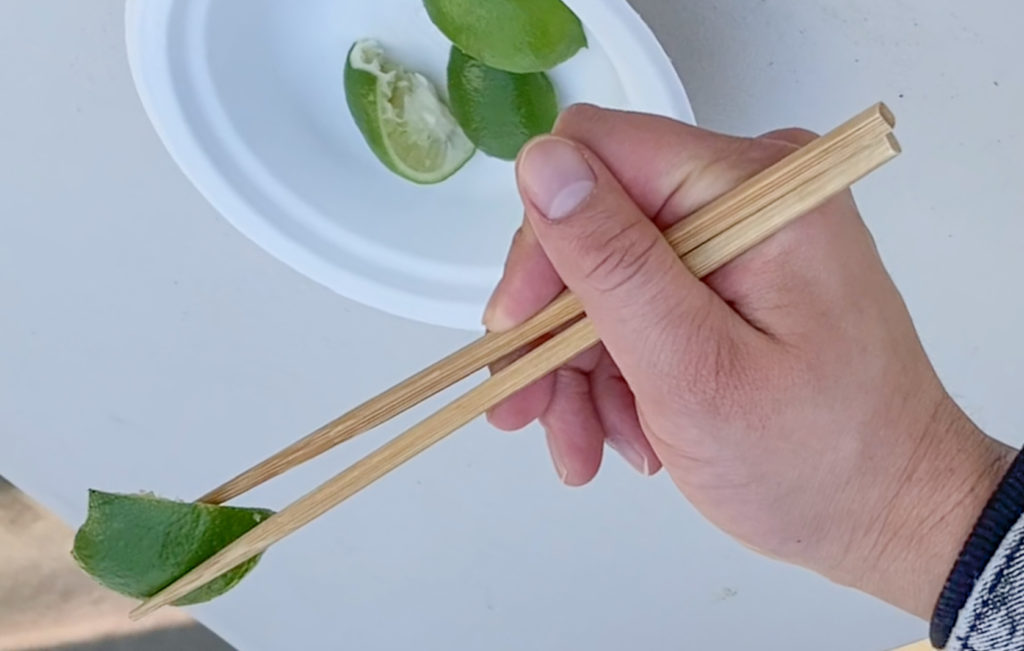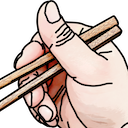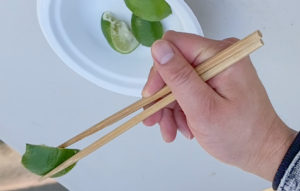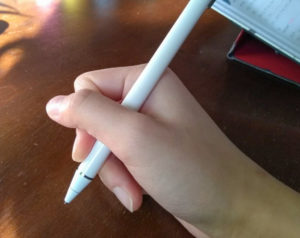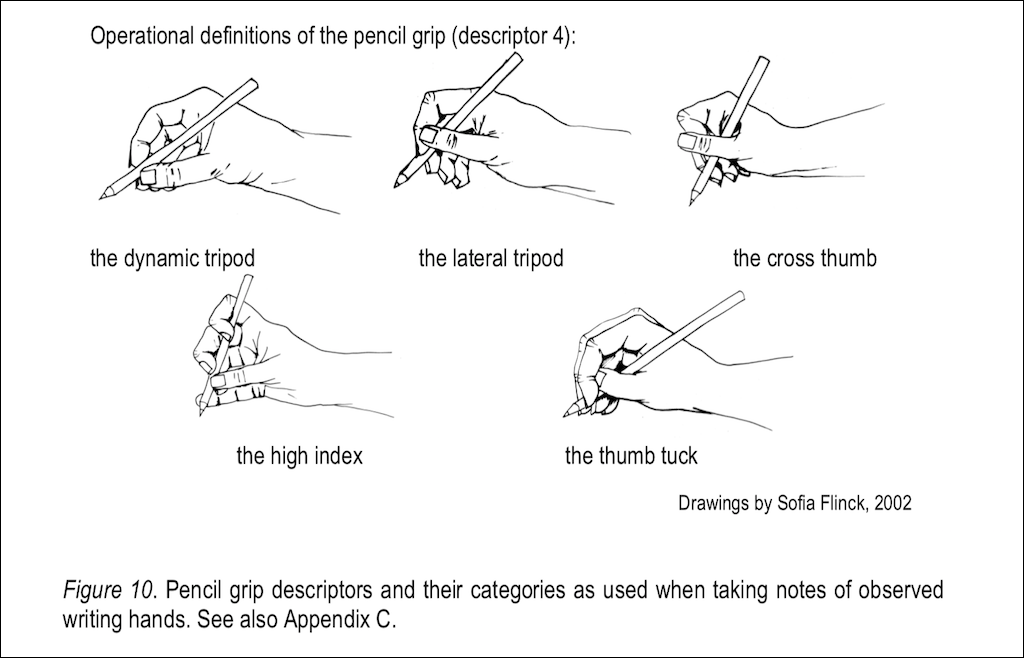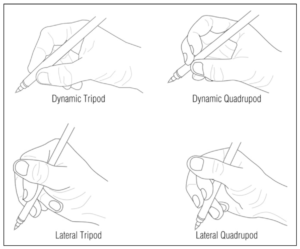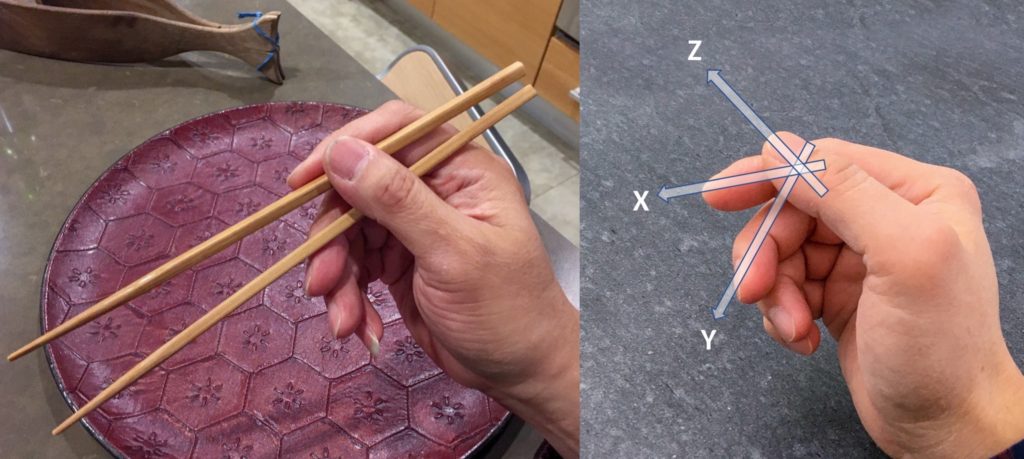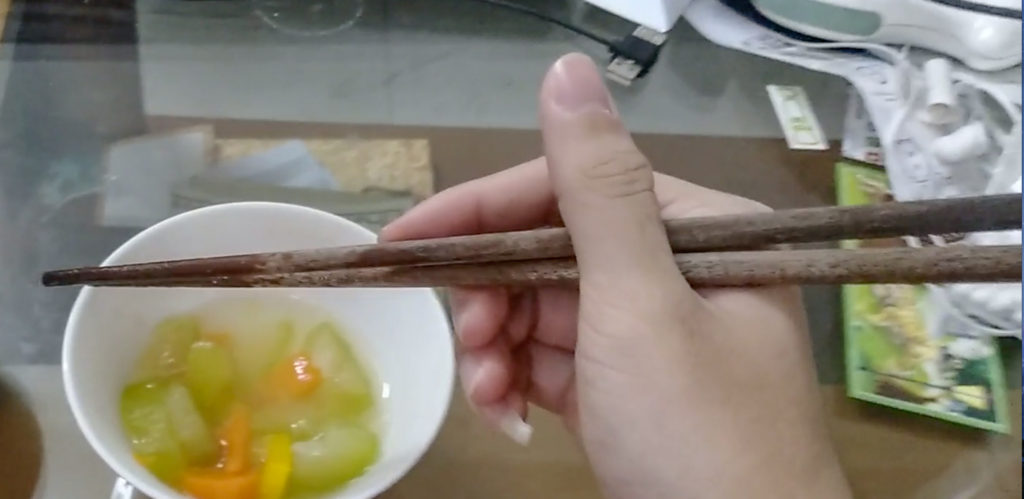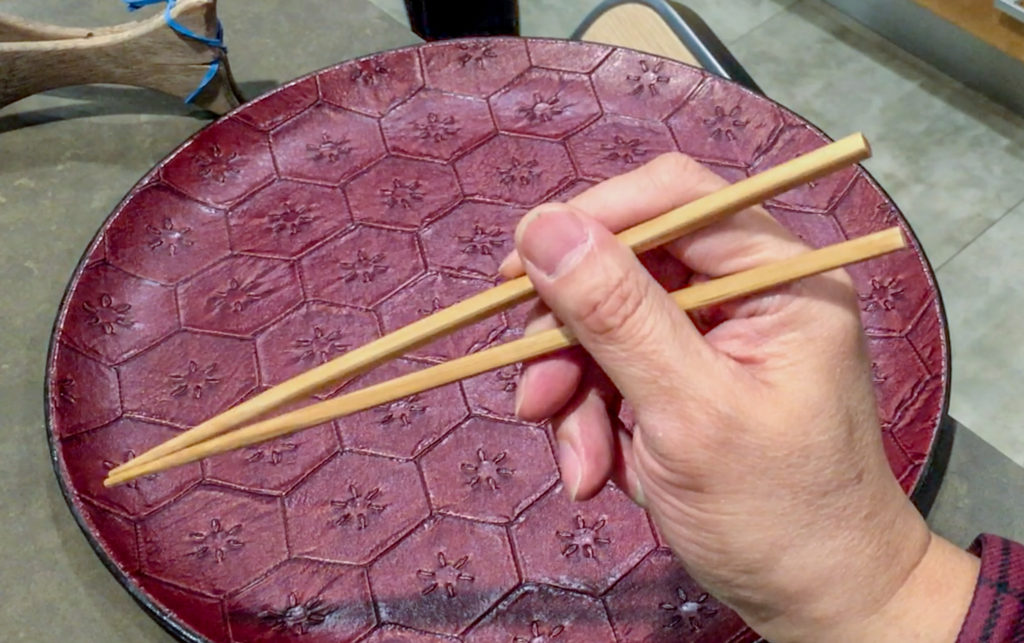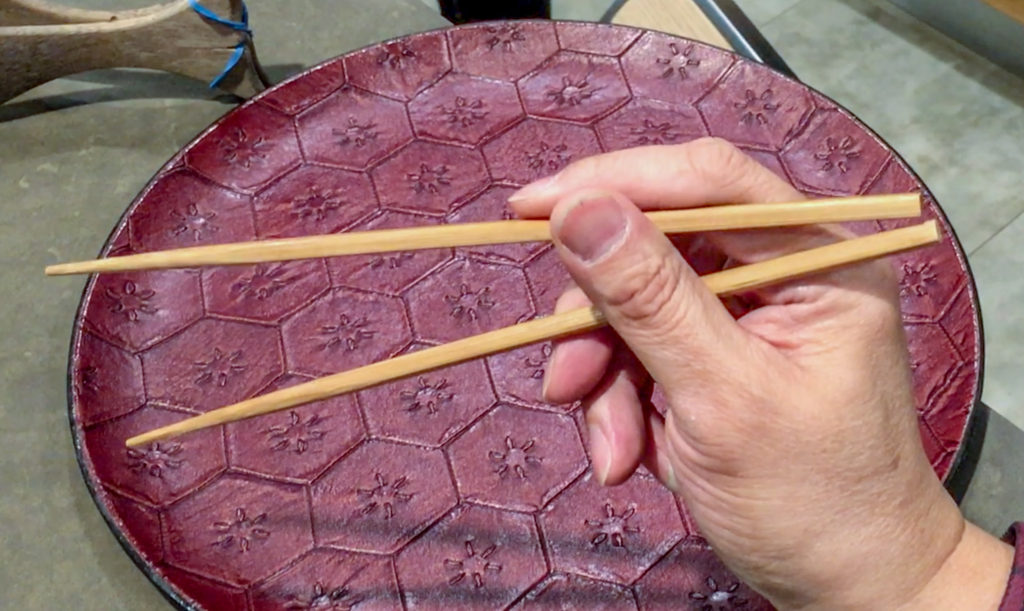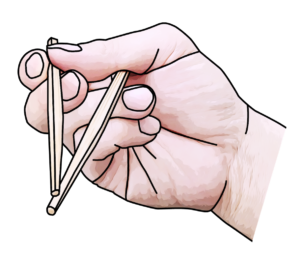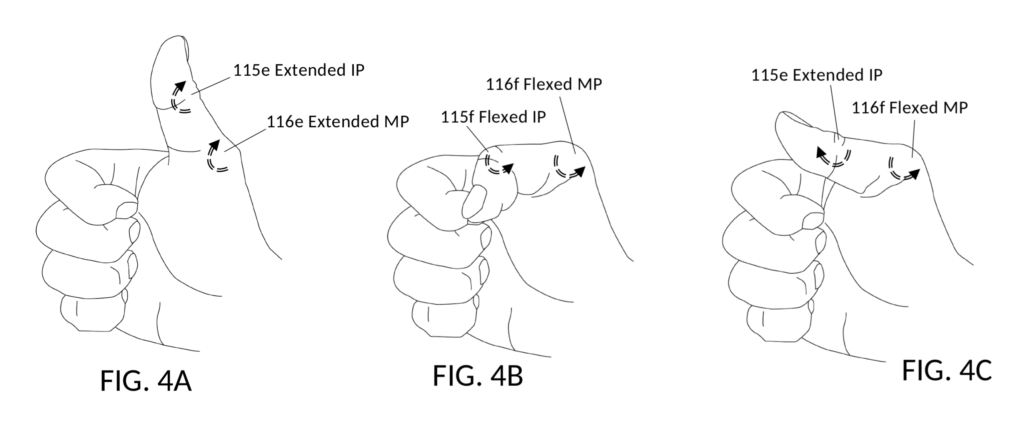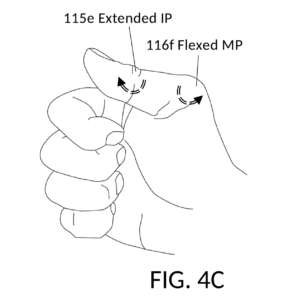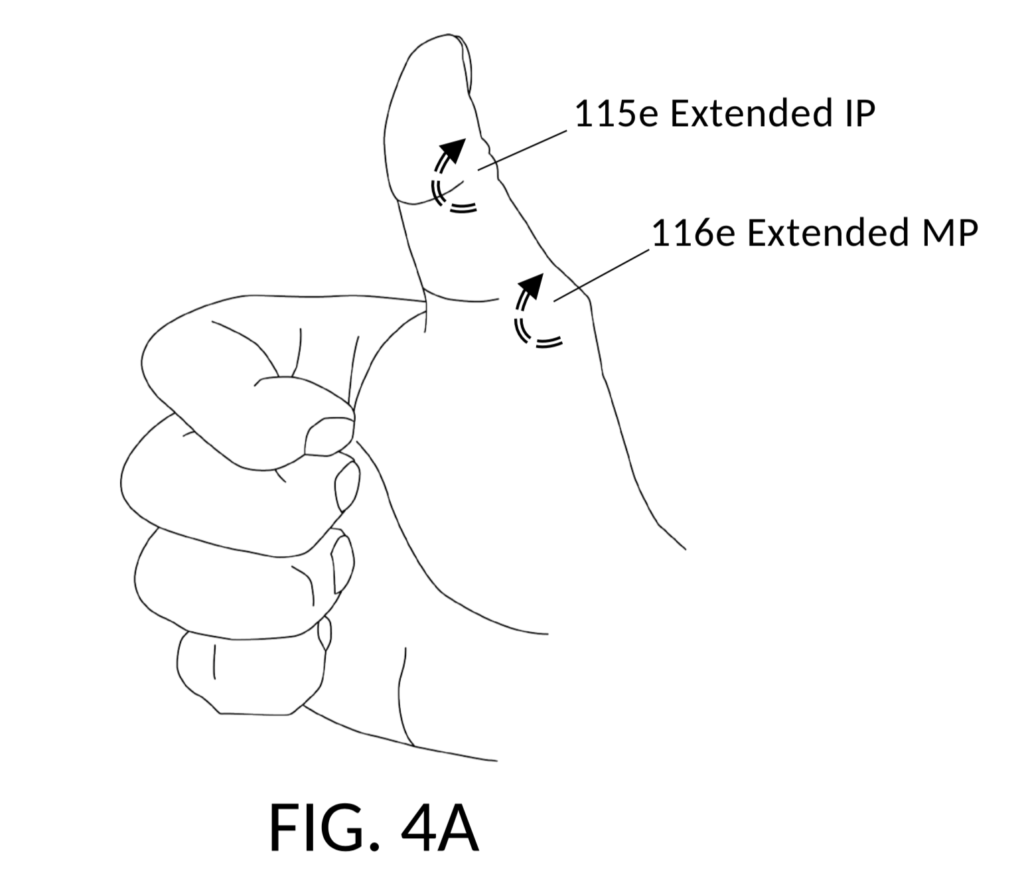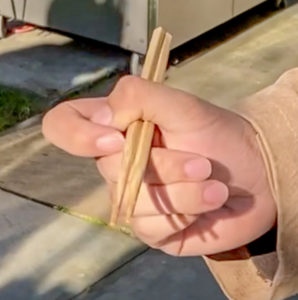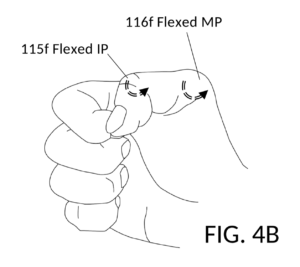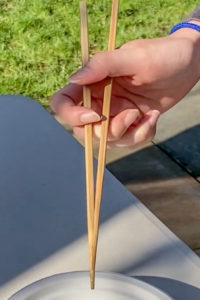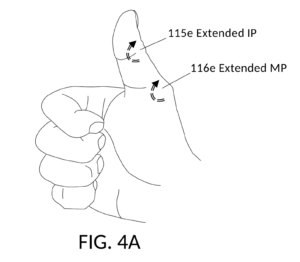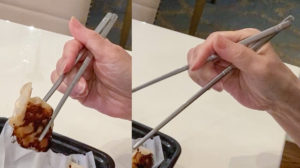Last Updated on June 30, 2021 by Staff
Lateral grips form the largest grip family in all of chopstick grips we have studied so far, at the time of publication of this article. Many Lateral variants have been documented and analyzed. While they vary greatly in how they work when extending tips of chopsticks open, all of them share one common finger posture when a practitioner compresses two chopsticks to pick up food. We call this the “compression posture”, and it is shown below.
Table of Contents
Named after a penhold
This chopstick grip is named after a popular penhold called “Lateral Tripod”. This penhold is shown below to the right. The penhold is known as the Lateral Tripod, because 1) three fingers form a tripod to sandwich the pen (thumb, index finger and middle finger), and 2) the thumb crosses the pen, and the pad of the thumb tip rests on the lateral (radial) side of the index finger (see terminology).
We dove deeper into this Lateral penhold, and how its use correlates to the adoption of certain chopstick grips in Hold Chopsticks like a Pen. One key characteristics of the Lateral penhold is the disuse of the tip segment of the thumb. Many chopstick grips also feature this disuse of the thumb tip, as discussed in Using vs not using the Thumb. In many ways, Lateral chopstick grips share biomechanical similarities with its namesake penhold, when it comes to clutching two chopsticks firmly in the hand.
Lateral Tripod is but one of a few common penholds. Four common penholds are shown below. The first two, Spencerian and Caswellian, are our own names, as they are not well identified elsewhere. We named them in order to contrast chopstick grips to these penholds, as discussed in the Hold Chopsticks like a Pen article. The third, Dynamic Tripod, is the most popular and officially-taught penhold in the Western world.

We should note, however, that the name Lateral Tripod is generally misunderstood. Scholarly literature actually has two different names for two often-confused penholds. The Lateral Tripod technically refers to a penhold where the thumb only crosses partially over the pen, as shown below. The version where the thumb fully crosses over the pen is called Cross Thumb.
However, the picture shown below from 2012 has since swept the web. It has gone viral many times over, lumping Cross Thumb with Lateral Tripod into one penhold. It has been posted to Reddit umpteenth times. And has been used in news articles ever since. See Schwellnus et al DOI: 10.5014/ajot.2012.004515 where it started.
Thus we go with the flow, and named our chopstick grip “Lateral”, instead of “Cross Thumb”.
Following is the stereotypical Compression posture of all Lateral chopstick grips, seen from various angles.
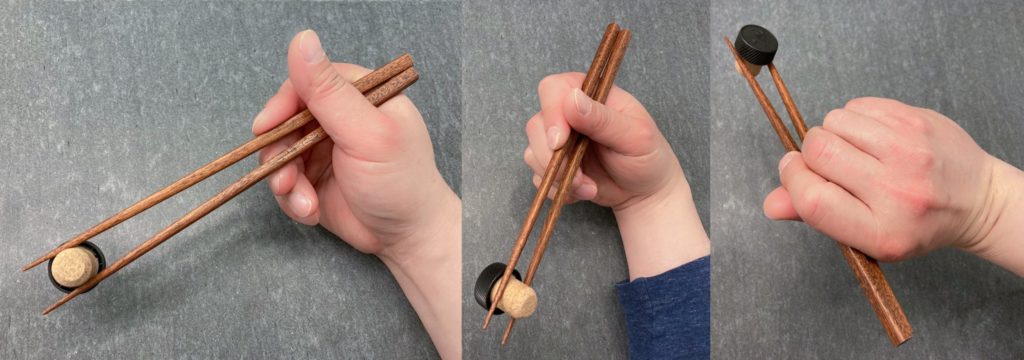
Compared to the Righthand Rule grip
The compression posture of all Lateral chopstick grips look similar to the Righthand Rule grip. These two chopstick grips are shown below, for comparison. In both grips, the two chopsticks are clutched by the thumb, the index finger and the middle finger. And the rear ends of chopsticks rest on the purlicue. In both grips, the pad of the index finger pushes the top chopstick towards the bottom chopstick. The knuckle of the middle finger pushes the bottom chopstick towards the top chopstick.
But these similarities are deceiving. Note how the first segment of the thumb in Lateral Turncoat shown above left does not touch either chopsticks at all. Only the thumb base is used on Lateral grips. In contrast, the pad of the thumb firmly operates the top chopstick in Righthand Rule shown above right. Lateral grips differ from Righthand Rule, mainly on its disuse of the tip segment of the thumb.
This key difference is illustrated again by the two pictures shown below. This time, a different variant of the Lateral grip is shown. Again, the disuse of the tip of the thumb in Underswing Lateral on the left is apparent, when contrasted to the Righthand Rule on the right. Both pictures show what we call the Closed Posture, when tips of chopsticks touch each other.
When it comes to extending tips of chopsticks apart, however, things become interesting. Righthand Rule on the right uses the tip segment of the thumb to move the top chopstick, as all thumb-using chopstick grips do. Almost all Lateral grips banish the thumb tip from operating any chopsticks. Underswing Lateral shown below uses a combination of thumb base and index finger to pry the top chopstick open.
This use versus disuse of the thumb tip is one crucial factor when we analyze an alternative chopstick grip. All chopstick grips can be classified into either the using-thumb-tip camp, or the not-using-thumb-tip camp. This topic is documented in Using vs not using the Thumb.
No need for the Caswellian thumb pose
Many thumb-tip-using grips require an unnatural thumb configuration that we call the Caswellian thumb pose. It is discussed at length in Caswellian thumb and chopsticks. This unnatural thumb pose is illustrated below, showcasing the Closed posture of Standard Grip.
This unnatural thumb pose is found below in FIG. 4C. Many people are not able to make this unnatural thumb pose comfortably. On the other hand, most people can comfortably make the thumbs-up pose in FIG. 4A, and the closed-fist pose in FIG. 4B.
Following pictures compare Standard Grip’s thumb pose (left) to FIG. 4C (right). Note how the MP joint is bent nearly to 90°, while the IP joint is flattened at 180°.
We hypothesize that Lateral grips are popular, partly due to them eschewing this unnatural thumb pose. This is a consequence of the disuse of the tip of the thumb. Note how the Lateral grip shown below left uses a comfortable thumb pose similar to the thumbs-up gesture shown in FIG. 4A. That is, both MP joint and IP joint of the thumb are flattened at 180°.
Not all Lateral grips adopt the thumbs-up gesture. Many make use of the closed-fist thumb pose. Another Lateral grip is shown below left. This one employs a comfortable thumb pose where both MP joint and IP joint of the thumb are bent.
A variation of the closed-fist gesture is where neither MP joint nor IP joint are bent at 90°. Some Lateral grips adopt this thumb pose half-way between closed-fist and thumbs-up. One such Lateral grip is shown below left.
Lateral Classic
Variant grips of the Lateral family abound. But only one can be the stereotypical grip of this family. We call this stereotypical grip the Lateral Classic. Key postures of this grip are shown below. From left to right, they are: 1) Abutting posture, 2) Compression posture, 3) Closed posture, and 4) Open posture.

The same Lateral Classic grip is shown again below, from a different from point of view. In this classic version, fingers do not appear to move much from posture to posture. To pry the two chopsticks open, the base of the thumb works together with the middle finger to nudge both chopsticks apart (far right), and to bring them back together (far left). We named this classic variant Lateral Squid.
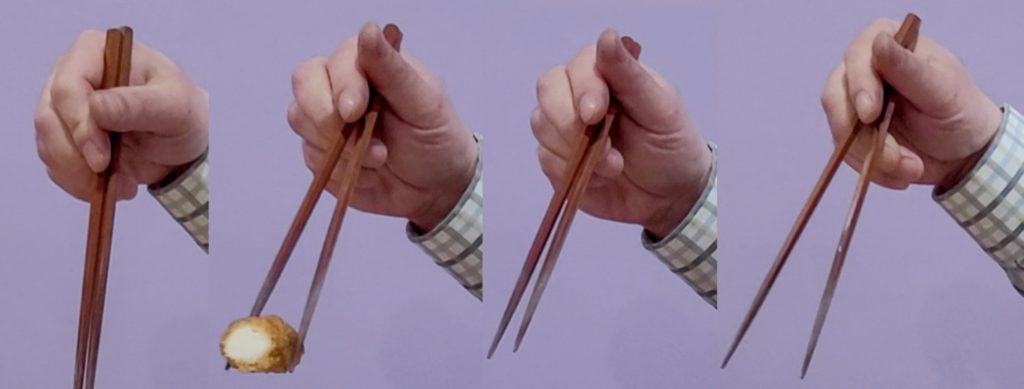
Shown below is a different variant of the same Lateral Classic grip. Finger movements of this practitioner cover greater distances. As a result, chopstick movements are more clearly appreciated. But the biomechanics remains the same as in User26 shown above. We named this variant Lateral Chick. It is the “type species” of the Lateral Classic subfamily.
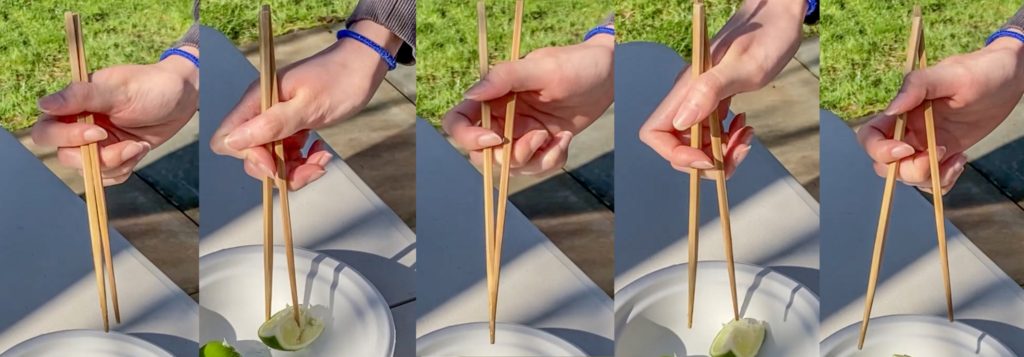
Lateral Turncoat
A variant of the Lateral family almost looks the same as Lateral Classic. It called Lateral Turncoat, and is shown below. Carefully follow the thumb tip and the middle finger in the four postures. Note how the tip segment of the thumb changes from unused on the far left, to being instrumental in holding the top chopstick on the far right. Also note how the tip of the middle finger braces against the top chopstick, as the thumb prods the top chopstick up.
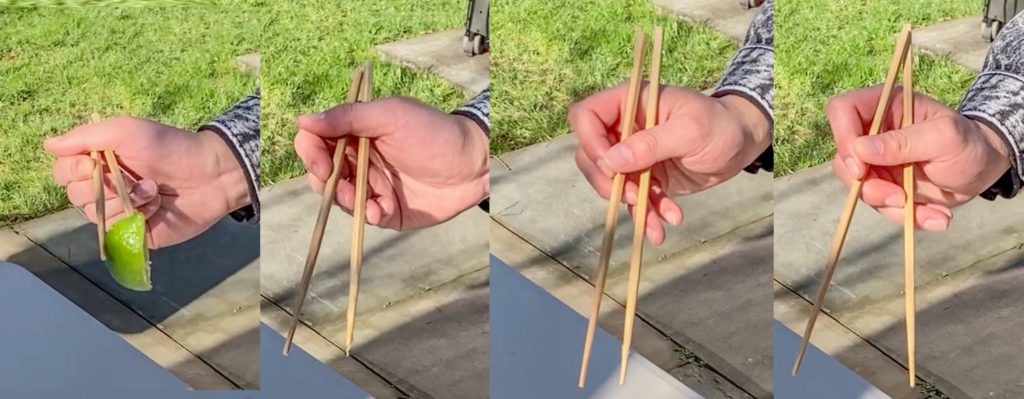
This variant is the only Lateral grip which does make use of the tip segment of the thumb, when prying open chopsticks. As they say, the exception proves the rule. This is one such exception in Lateral grips. At the open posture and max open posture, Lateral Turncoat becomes a thumb-using grip. In fact, the open posture of Lateral Turncoat looks identical to the Turncoat grip. Thus the name of this variant.


Shown below is another practitioner wielding the same Lateral Turncoat grip.

Below is yet another practitioner wielding the a grip similar to Lateral Turncoat. In this case, flat Korean chopsticks are used. These are much harder to use compared to square chopsticks, as they are virtually impossible to roll. See the article on planetary gears about why rolling of chopsticks are important to chopsticking. It is just different and special enough, that we gave this variant it own name: Lateral Gangnam Style.

Sideway Lateral
We have previously identified a new factor to describe and classify related chopstick grips, based on how the top chopstick swings differently, in variant grips. This is detailed in Out with the Crossed Type, in with the Under Swing. Using the same insight, we can classify all Lateral grips based on three types of swings: 1) classic swing, 2) sideway swing, and 3) underswing. Lateral grips discussed so far are “classic swing” variants. Lateral Classic and Lateral Turncoat both feature the “classic swing”, where fingers nudge open the top chopstick, swinging it upward.
Now we will show you a “sideway swing” variant. Pictures below illustrate how a Sideway Lateral practitioner prods the top chopstick open sideways, starting from the far left, and ending at the far right. Note how the index finger nudges the top chopstick to the side. Also observe how the base of the thumb relents to accommodate the movement of the rear end of the top chopstick. The index finger and the thumb makes the well-known money gesture. Thus the name Lateral Money grip.

Underswing Lateral
Similarly, there is an “underswing” variant of the classic Lateral grip. Naturally, we call variants in this subfamily Underswing Lateral grips, and its key postures are shown below. In this variant, the thumb moves rearward to prod the rear of the top chopstick upward. At the same time, the tip of index finger nudges the top chopstick downward.

Shown below is another practitioner wielding the same Underswing Lateral grip. This time key postures are shown from a different point of view, allowing the movement of the index finger to be better appreciated. Note how the tip of the index finger is inserted between the two chopsticks to prod them open.

We named this underswing variant Lateral Thumb Wrestler, because its thumb movements are identical to those used in thumb wrestling.
Distinguished variants: Chicken Claws
As mentioned earlier, the Lateral family encompasses a large varieties of chopstick grips. Some of its variants have been given specific names elsewhere on marcosticks.org, without explicit references to their “lateral” origins in their names.
One such variant is shown below. This is the Chicken Claws grip. As can be appreciated from the Abutting posture shown below left, Chicken Claws is clearly a type of Lateral grip. Its Abutting posture is indistinguishable from all other Lateral variants. But it’s Max open posture shown below right is quite different. In the Max open posture, the middle finger no longer makes contact with the bottom chopstick. This is a significant departure from all other Lateral variants. The bottom chopstick rests on the ring finger instead, at this posture. The tip segment of the thumb is used to pry open the bottom chopstick. This is also different from other Lateral variants.
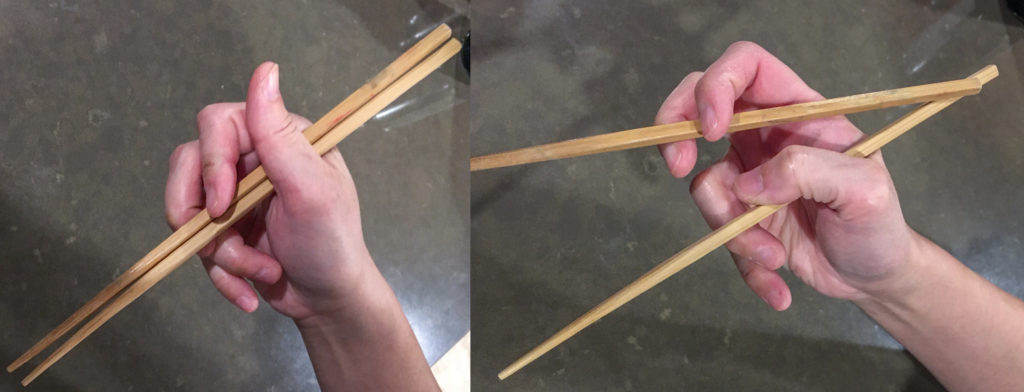
More importantly, the index finger and the middle finger sandwich the top chopstick at the Max open posture, moving it upward and away from the bottom chopstick. This feature breeds its own subfamily of chopstick grips, including Dangling Stick and Muppet Grip, as illustrated in the Family Tree of Chopstick Grips.
Differences notwithstanding, there is a clear resemblance between Chicken Claws and Lateral Classic. For comparison, the Abutting posture and the Max open posture of Lateral Classic is shown below. They look very similar to Chicken Claws. As mentioned, subtle differences are found in where the thumb pad lies, and whether it is used in extending chopstick tips. In Lateral Classic, the bottom chopstick always rests on the middle finger, even in the Max open posture. This particular Lateral Classic variant is therefore named Lateral Chick.
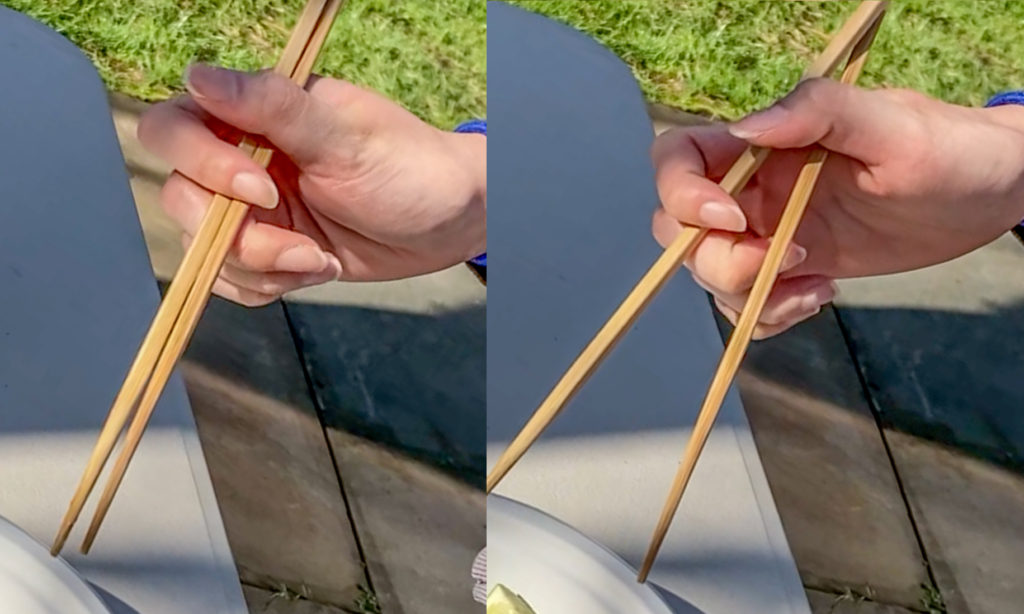
Distinguished Variants: Scissorhand Grip
Yet another notable variant with its own name is the Scissorhand Grip. Its Abutting posture shown below left clearly identifies it as belonging to the Lateral family. But its Max open posture shows that the bottom chopstick is pushed far away downward, such that it no longer rests on the middle finger. In fact, only the base of the thumb holds the bottom chopstick at the Max open posture, and prevents it from falling off the hand.
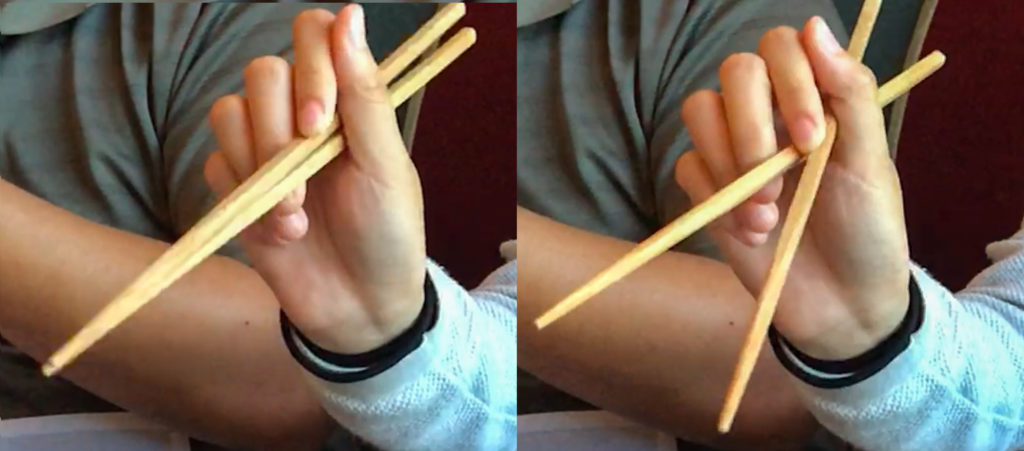
Yet again, there is a clear resemblance between Scissorhand Grip and Underswing Lateral (Lateral Thumb Wrestler). For comparison, the Abutting posture and Open posture of Lateral Thumb Wrestler is shown below. They look very similar to Scissorhand Grip. As mentioned, one subtle difference is how the bottom chopstick continues to rest on the middle finger at the Open posture, in Underswing Lateral.
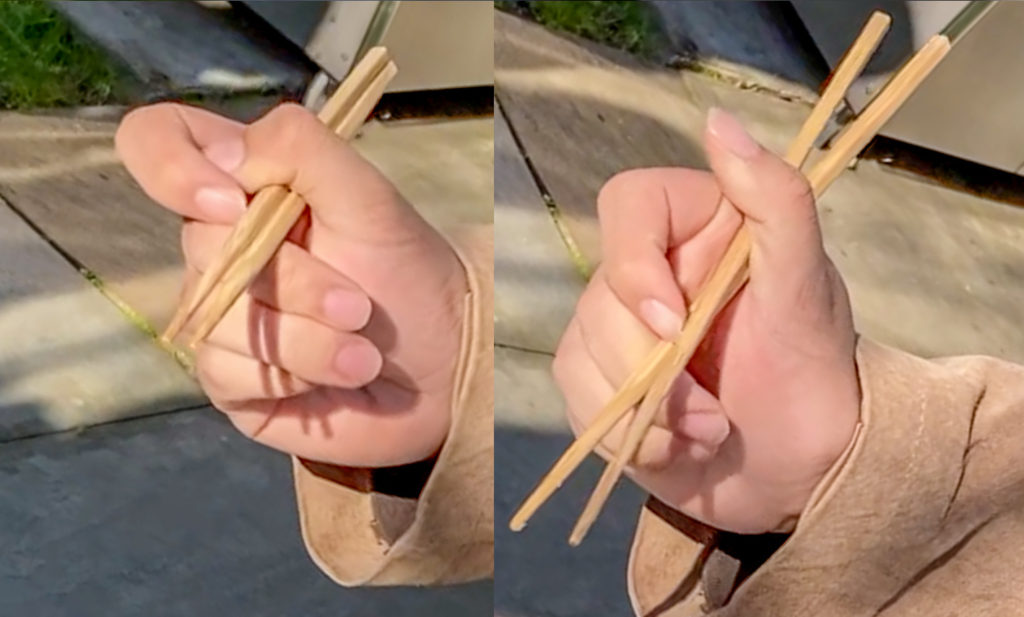
Another difference between Scissorhand Grip and Lateral Thumb Wrestler is how the index tip is used. The picture found below right shows the tip of the index finger being inserted between the two chopsticks, to nudge the top chopstick downward. That is not how the index finger works in Scissorhand Grip.

Taiwanese: 指頭母倚靠二指邊仔
This grip is known as 指頭母倚靠二指邊仔 (Chéng-thâu-bó óa khò jī-cháiⁿ piⁿ–a) in Taiwanese. This is not a real grip name, but a long and descriptive name of a family.

